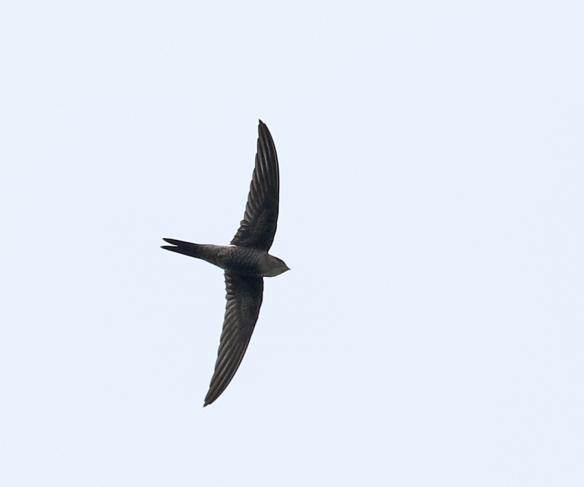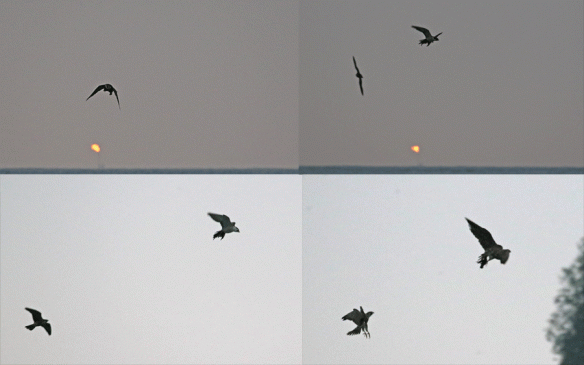The day dawned bright and sunny, with little wind, after a clear night. Initially, it seemed like there was not much about, and we guessed that birds had taken advantage of the clear night to move on. However, when we got to the football field – which still had several rainwater pools – we found two juvenile Pacific Golden Plovers, 2 Little Ringed Plovers, a small flock of 8 Red-throated Pipits and several Eastern Yellow Wagtails.
We then decided to work the scrubby bushes around the field, and before long Mike called our attention to a warbler which had just emerged into some dead branches at the edge of a bush. It was immediately obviously something new, and we cycled through a couple of possibilities before quite quickly realising we were looking at…a Willow Warbler! This is a species all of us are familiar with from Europe, but it was not exactly what we were expecting to see in Borneo! The bird sat motionless, other than repeatedly flicking its tail, as we edged around to get a better angle. As we did so, a Japanese Sparrowhawk made a dash for the warbler and pulled out at the last moment as it became aware of us. The warbler froze, apparently in shock, for several minutes, enabling us to get lots of photos before it eventually flew off to an adjoining bush. We took a few moments to compare notes and revel in the rush of adrenaline at having found a ‘mega’ rarity, reflecting that our attention had probably also saved the Willow Warbler’s life!
We then spread out to try to relocate the bird, and almost immediately I flushed a largish, long-tailed, sand-coloured passerine which flew low to the next bush. It wasn’t ringing any bells, and when I got the bins onto the streaky-crowned head, I was still completely flummoxed as to its identity – till I saw the slightly bulbous, conical bill, and the penny dropped – Black-headed Bunting! The bird sat motionless in the bottom of the bush for a short while, enabling Mike and Yann to get onto it, before flying on, and once again we conferred, and checked our cameras, to make sure we weren’t hallucinating! Two megas in a matter of minutes, and suddenly I had moved from 598 species for the year to the magic 600! All buntings are rare in Malaysia, only five species have been recorded. This was about the 5th Black-headed Bunting record for the country, and my first bunting of any description.
We continued checking the bushes around the field, and though we could not relocate either the warbler or the bunting, continued to turn up new birds, including several Brown Shrikes and a Taiga Flycatcher. Grey-faced Buzzards and Chinese and Japanese Sparrowhawks migrated overhead, and there were a Pacific Swift and a number of Red-rumped Swallows and Sand Martins too, both rarities in Borneo. A small flock of 10 Chestnut-cheeked Starlings perched in a casuarina tree nearby. Having exhausted possibilities at the football field, we walked eastward toward the point, seeing Blue-and-white, Grey-streaked, Asian Brown and a second Taiga Flycatcher on the way. At the point itself, we came across our fifth flycatcher species of the day – a stunning male Narcissus!
We returned to the football field after lunch but found it quiet, and then moved to a new area where we located another flock of 7 Chestnut-cheeked Starlings and a Japanese Leaf Warbler – a striking individual with pale lemon yellow underparts.

Where bird names get confusing! The grey bird on the left is an Eastern Yellow Wagtail, while the yellow bird on the right is a Grey Wagtail!
Moving to the west end of the island in late afternoon, we sat down to watch the frigatebirds gather to roost. As we sat watching, suddenly a needletail flew into the bay. Its squat, compact shape indicated that it was either White-throated or Silver-backed, and as it banked against the dark forest behind, there was no pale throat visible, suggesting it was the latter – another potential first for Borneo! However, at that moment, the Peregrine which we had seen perched on a nearby dead tree earlier powered into view, easily overhauled the needletail and knocked it into the sea! After a couple of failed attempts, the falcon plucked the doomed swift out of the water, but was then in turn chased down by a second Peregrine, forcing it to release its prey (which still appeared to be alive). The second Peregrine caught the needletail in midair and flew off with it. At that moment, a large stingray broke the water surface where the needletail had been moments earlier, leaping high in the air and falling back into the water with a mighty splash!

This shows the moment when the prey changed hands. The swift appeared to be trying to fly at this point.

Seconds later this Stingray broke the surface where the needletail had been just a few moments before!
Wow! What a spectacular finale to what had been an amazing day! Or not quite, as we continued to watch and count an estimated 5200 frigate birds (Lesser and Christmas Island) congregate over Linggisan Island like a massive bee swarm, before settling down to roost at last light.
Our passerine count for the day included 5 Brown Shrikes, 7 Sand Martins, 12 Red-rumped Swallows, 1 Willow Warbler, 9 Arctic Warblers, 1 Japanese Leaf Warbler, 8 Grey-streaked Flycatchers, 2 Asian Brown Flycatchers, 9 Blue-and-white Flycatchers, 1 Narcissus Flycatcher, 2 Taiga Flycatchers, 17 Chestnut-cheeked Starlings, 28 Eastern Yellow Wagtails, 7 Grey Wagtails, 8 Red-throated Pipits and 1 Black-headed Bunting!





























OMG, amazing records, Dave, Congratulations on the Willow Warbler and Black-headed Bunting, the former is something I never heard of. They will disappear and be impossible to find when they reach mainland Borneo.
Too bad on the needletail though, sigh.
May I also have your permission to extract your records for Sabah notable sightings and upload some of the images to BBI for records.
Terima kasih.
Yes of course Wong!